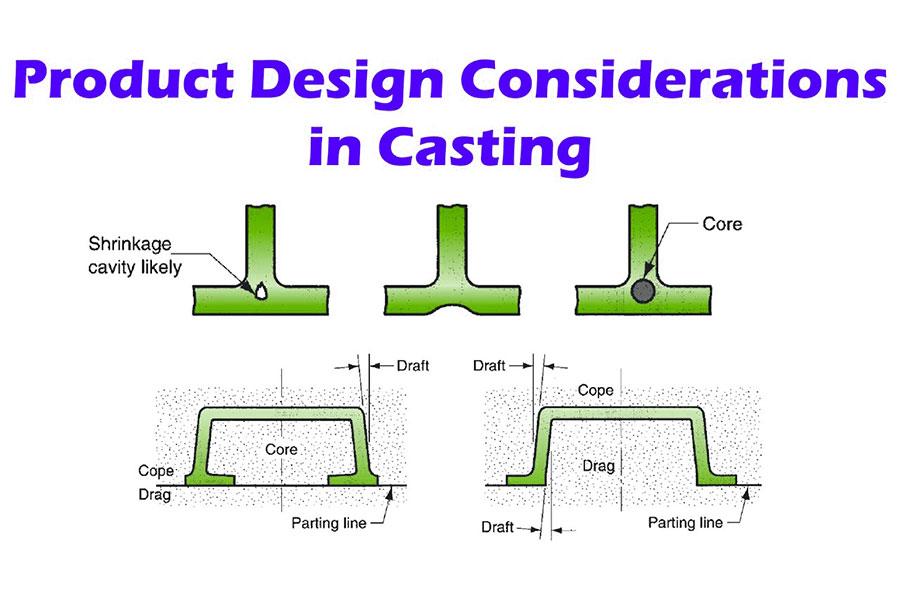As an important molding process, metal casting is widely used in various fields of manufacturing. To ensure that the cast metal products have good quality and performance, designers and engineers need to consider a number of key factors during the metal casting process. This article will explorekey design and engineering considerations in metal casting.
What is Metal Casting?
Metal casting is a manufacturing processthat involves pouring molten metal into molds to create 3D metal parts. The mold contains cavities of the desired geometry, and the molten metal cools to form the solidified part.
The word "cast" also refers to parts made through a casting process, which dates back 6,000 years. Historically, casting processes have been used to create complex and large parts that would be difficult or costly to create using other manufacturing processes.
Casting is the first choice for complex geometriesbecause it is more cost-effective and the process is simpler compared to, for example,CNC machining.But casting is also widely used for the simplest shapes because of its fast turnaround time and large production capabilities. Today, the use of cast products is so widespread that no matter what environment you are in, you cannot avoid using cast products. Some examples of cast metal products include engine blocks, fire hydrants, electric motors, tools, traffic lights, manholes, pipes, valves, and various fittings.
What Are the Key Design Considerations For Metal Casting?
Metal casting design is a complex and delicate processinvolving the consideration of several key factors. Understanding these considerations can help customers select the best metal casting process for their specific application. It is important to note that metal casting design is only one consideration when selecting a metal casting process and must be balanced with other factors to meet customer needs.
1.Metal casting shape
The first factor considered inmetal casting design is shape. If the part is typically round (i.e. a ring, sleeve, or tube), then centrifugal casting may be a suitable metal casting process. If the part is not round and has complex geometries such as internal channels or ribs, then investment casting orsand castingis most suitable. The remaining design considerations focus on the choice ofinvestment castingor sand casting.
2.Metal casting dimensions
Sand castings come in a much wider range of sizes than investment castings. If the casting weighs less than 1,200 pounds, the customer must consider the level of detail and overall geometry when deciding between investment castings and sand castings. Cast quality is supported by solidification modeling software. The software simulates the flow of molten metal into the mold and analyzes predicted solidification as the mold cools. The model supports mold design to ensure parts meet requirements.
3.Dimensional tolerance
Dimensional tolerance refers to the allowable deviation of a metal casting from the required dimensions. Generally speaking,investment casting has tighter tolerances than other metal casting methods(for example, +/- 0.010 inch for the first inch, +/- 0.004 inch for every inch thereafter), even with fine details and interior The same goes for the components of the channel. While sand casting typically cannot achieve the dimensional tolerances of investment casting, it can provide complex geometries and details at greater overall dimensions.
4.Surface treatment
Surface finish refers to the external texture of a part after metal casting, measured in root mean square (RMS). The as-cast surface finish of investment casting is typically finer (60 to 200 RMS) than that of sand casting (250 RMS or more). This often reduces the need for machining (see below). Sand casting can be machined to achieve a finer surface finish, but this comes at additional cost and lead time. If a fine surface finish is not required,sand casting can provide complex geometriesand details at an overall cost that is typically lower than investment casting.
5.Processing requirements
Metal casting designsmust take into account the amount of metal removed from the casting through machining to achieve the desired shape and features. Machining can significantly increase costs and delivery times. Almost all components produced by Longsheng undergo some degree of machining by Longsheng or the customer after shipment.
What Materials Are Used in Metal Casting?
A wide variety ofmaterials are used in metal casting, each of which is widely used in different industrial fields due to its unique physical and chemical properties. Here are some of the major metal casting materials:
Cast iron
Cast iron is an iron-carbon alloy with a carbon content greater than 2.1%. It has excellent castability, wear resistance, shock absorption and other characteristics. There are many types of cast iron, generally divided into white cast iron, gray cast iron, malleable cast iron, ductile iron, etc. Gray cast iron has three structures: ferrite + graphite, ferrite + graphite + pearlite, and pearlite + graphite. It is suitable for manufacturing parts that bear static loads. Malleable cast iron is a high-strength cast iron obtained from white cast iron after long-term graphitization annealing. It is suitable for manufacturing parts that bear impact loads. Ductile iron is obtained by adding spheroidizing agents and inoculants to spheroidize graphite. Its strength, plasticity, and toughness are higher than other cast irons, and it is suitable for manufacturing complex parts that bear higher loads.
Aluminum alloy
Aluminum alloys are widely used due to their low density, high strength, good corrosion resistance and excellent casting properties.Aluminum alloy has good casting performance and high fluidity. It can die-cast precision parts with complex shapes and thin walls, and the surface of the castings is smooth. In addition, aluminum alloys can also undergo a variety of surface treatments, such as electroplating, spraying, etc. Common cast aluminum alloys include ZL101, ZL102, etc. They are suitable for casting parts with complex shapes and medium load, as well as parts requiring high air tightness, corrosion resistance and good welding performance.
zinc alloy
Zinc alloy is an alloy based on zinc with the addition of other elements. It has good casting properties and mechanical properties. Zinc alloy has a large specific gravity, low melting point, and is easy to die-cast. At the same time, zinc alloy castings have a smooth surface and can be processed in a variety of surfaces. However, zinc alloy has poor corrosion resistance. When the impurity elements in the alloy composition exceed the standard, it will cause the casting to age and deform. In addition, zinc alloy die castings are not suitable for use in high and low temperature (below 0°C) working environments. Common zinc alloys include Zamak3, Zamak5, etc., which are suitable for castings with low requirements for mechanical strength and castings with certain requirements for mechanical strength.
Magnesium alloy
Magnesium alloy has the characteristics of low density, good specific strength and stiffness, good vibration damping performance, and strong electromagnetic interference shielding ability. Magnesium alloy has relatively poor casting performance, low fluidity, and greater tendency to crack and shrink. However, magnesium alloys are widely used in automobiles, aerospace, electronics and other fields because it can significantly improve the fuel economy, reduce exhaust emissions and reduce weight of products. Common cast magnesium alloys include AZ91D, AM60B, etc., which are suitable for manufacturing automotive parts, aerospace parts, etc.
Copper alloy
Copper alloy has the characteristics of good electrical conductivity, thermal conductivity, corrosion resistance and low friction coefficient. Copper alloys have excellent casting properties and can be made into castings with complex shapes. Copper alloys are widely used in the electronics industry, machinery industry, aerospace industry, chemical industry and other fields. For example, in the electronics industry, copper alloys are often used to make electronic components; in the machinery industry, copper alloys are often used to make mechanical parts that require high wear resistance and corrosion resistance; in the aerospace industry, copper alloys are often used Used to make parts with high strength and toughness. Common cast copper alloys include brass, bronze, etc. The table below summarizes and compares theadvantages and disadvantages of common metal casting materials.
|
Cast material |
Advantages |
Disadvantages |
|
Aluminum Alloys |
Lightweight; high dimensional stability; easy to cast; good corrosion resistance; high thermal and electrical conductivity; retains strength at high temperature. |
Requires use of cold-chamber machines. |
|
Zinc Alloys |
Easiest to cast; high ductility; excellent surface smoothness; high impact strength; easily plated; economical for small parts; promotes long die life due to low melting point. |
Requires coating to resist corrosion; high density. |
|
Cast Iron |
Low price, good wear resistance, strong compression resistance |
Easy to produce pores, brittle high |
|
Magnesium Alloys |
Easiest to machine after casting; excellent strength-to-weight ratio; lightest; use both hot- and cold-chamber machines. |
Rapidly oxidized. |
|
Copper Alloys |
High hardness; high mechanical properties; high corrosion and wear resistance; high dimensional stability. |
High cost; low die life; requires use of cold-chamber machines. |
What are the key engineering challenges in metal casting?
As an important material processing technology,metal casting plays a vital role in industrial production. However, there are also some key engineering challenges faced during the metal casting process.
- Improvement of casting quality and performance:With the development of modern industry, the quality and performance requirements for castings are increasing day by day. Castings need to have higher strength, toughness, wear resistance and corrosion resistance to meet the needs of various complex working conditions. To improve the quality of castings, it is necessary to start from many aspects such as the selection of raw materials, optimization of the smelting process, design and manufacturing of molds, and precise control of casting parameters.
- Control and Prevention of Casting Defects:Common defects in the casting process include porosity, inclusions, shrinkage holes, cracks, etc., which can seriously affect the performance and service life of castings. In order to control and prevent casting defects, it is necessary to study the flow, solidification behavior and defect formation mechanism of molten metal in the casting process, and take corresponding process measures to improve.
- Complexity and diversity of casting processes:There are many kinds of casting processes, including sand casting, continuous casting, investment casting, pressure casting, low-pressure casting, centrifugal casting and other methods. Each method has its specific scope of application and advantages and disadvantages. In the face of complex casting requirements and diverse casting shapes, how to choose the appropriate casting process and optimize its parameters is a challenging topic.
- Intelligence and automation of the casting process:With the development of intelligent manufacturing technology, the foundry industry is also gradually realizing intelligent and automated production. However, due to the complexity and diversity of the casting process, it is still difficult to achieve fully intelligent and automated production. It is necessary to strengthen the data collection, analysis and processing capabilities of the casting process, and develop intelligent control systems and automated production equipment to improve production efficiency and product quality.
- Environmental protection and sustainable development:In the process of metal casting, a large amount of waste gas, waste water and solid waste will be generated, which will cause serious pollution to the environment. In order to achieve environmental protection and sustainable development, it is necessary to take effective environmental protection measures and energy-saving and emission reduction technologies to reduce energy consumption and pollutant emissions in the casting process. At the same time, it is also necessary to develop green casting materials and processes to promote the green transformation of the foundry industry.
FAQs
1.What are the key design considerations for metal casting?
Key design considerations for metal castinginclude: Alloy selection: Select the appropriate alloy material based on the usage environment and performance requirements of the casting. Casting structure: Design a reasonable casting structure to avoid complex shapes and unnecessary wall thickness changes to reduce casting defects and improve production efficiency. Gating system design: A properly designed gating system ensures that molten metal can fill the mold cavity smoothly and quickly, and is conducive to the feeding and exhausting of castings. Cooling system design: According to the shape and size of the casting, design an appropriate cooling system to control the cooling rate and temperature gradient of the casting to avoid defects such as thermal cracks and deformation.
2.How does wall thickness affect casting design?
The larger the wall thickness, the slower the internal cooling rate of the casting, which can easily lead to defects such as coarse internal structures, shrinkage porosity, and shrinkage cavities. Excessive wall thickness can easily produce large residual stress during the cooling process, leading to deformation or cracking of the casting. Excessive wall thickness will increase the difficulty and cost of machining. Excessive wall thickness will also increase material and energy consumption, prolong the production cycle, and increase production costs. Therefore, when designing the wall thickness of castings, it is necessary to comprehensively consider the structure, performance requirements and processing difficulty of the castings to ensure stable and reliable quality of the castings and reduce production costs.
3.What are common defects in metal casting, and how can design prevent them?
Common defects in metal castinginclude pores, shrinkage cavities, shrinkage porosity, slag holes, cracks, cold shut, sand sticking, etc. To address these defects, the following preventive measures can be taken: Porosity: Control the gas content in the molten metal, increase the pouring temperature and exhaust efficiency, and prevent the gas in the cavity from being exhausted. Shrinkage and porosity: Reasonably design the pouring system and cooling system to ensure uniform cooling of all parts of the casting and avoid local overheating and undercooling. Slag hole: Strictly control the raw materials and smelting process to prevent impurities from entering the molten metal. Cracks: Reasonably design the casting structure to avoid stress concentration; control the pouring temperature and cooling rate to avoid the occurrence of hot cracks and cold cracks. Cold shut-off: Increase the pouring temperature and fluidity of the molten metal to ensure that the molten metal can fill the mold cavity smoothly and quickly. Sand sticking: improve the fire resistance and chemical stability of the mold, control the heating temperature and the oxidation degree of the alloy.
4.Why is mold design crucial for high-quality cast products?
Mold design is crucial to high-quality casting products, mainly reflected in the following: Mold is a key tool to form the shape and size of castings during the casting process. The design accuracy and manufacturing quality of the mold directly affect the shape and dimensional accuracy of the casting.
The design and manufacturing quality of the mold are also related to the performance, strength and wear resistance of the casting. Excellent molds can ensure that castings maintain stable performance in complex and changeable working environments. Reasonable mold design can reduce casting defects and improve the quality and qualification rate of castings, thereby reducing production costs and improving production efficiency. With the transformation and upgrading of the manufacturing industry and the continuous advancement of technology, mold design and manufacturing technology are also constantly innovating. Excellent mold design can promote the continuous development and progress of the foundry industry.
Summary
During the metal casting process, designers and engineers need to comprehensively consider multiple key factors such as the shape of the metal casting, the size of the metal casting, dimensional tolerances, surface treatment and processing requirements. However, in the process of metal casting, we are also faced with the improvement of casting quality and performance, the control and prevention of casting defects, the complexity and diversity of casting processes, the intelligence and automation of the casting process, and environmental protection and sustainable development. Engineering challenges. Through scientific and reasonable design and strict process control, we can ensure that the cast metal products have good quality and performance and meet various usage needs.
Disclaimer
The content on this page is for reference only.Longshengdoes not make any express or implied representation or warranty as to the accuracy, completeness or validity of the information. No performance parameters, geometric tolerances, specific design features, material quality and type or workmanship should be inferred as to what a third party supplier or manufacturer will deliver through the Longsheng Network. It is the responsibility of the buyerseeking a quote for partsto determine the specific requirements for those parts.Pleasecontact usfor moreinformation.
Longsheng Team
This article was written by multiple Longsheng contributors. Longsheng is a leading resource in the manufacturing sector, withCNC machining,sheet metal fabrication,3D printing,injection molding,metal stamping, and more.





